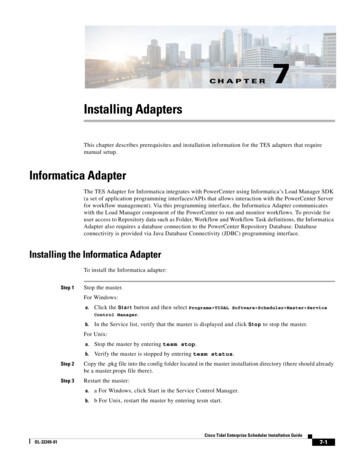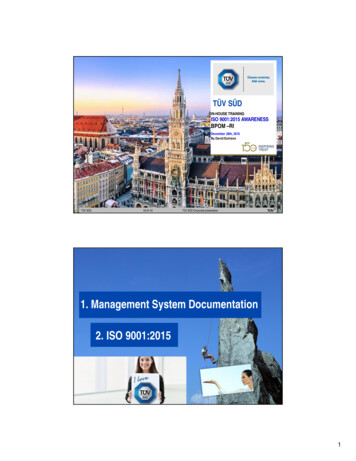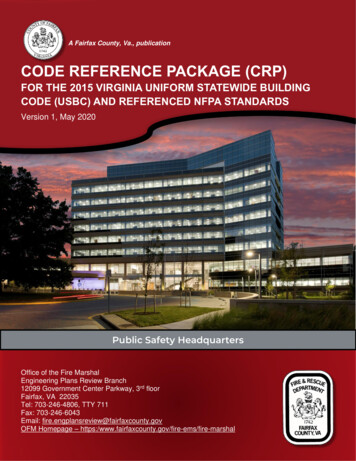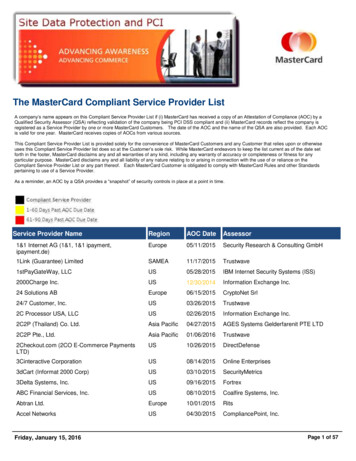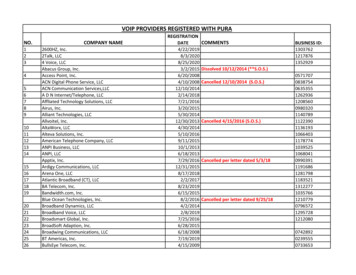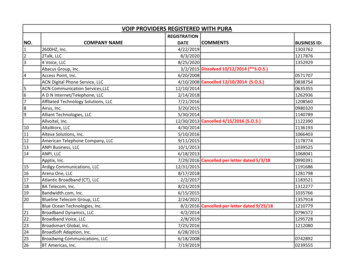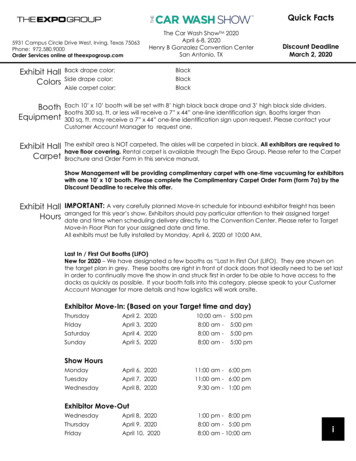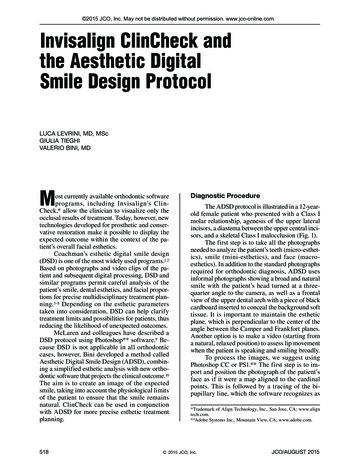
Transcription
2015 JCO, Inc. May not be distributed without permission. www.jco-online.comInvisalign ClinCheck andthe Aesthetic DigitalSmile Design ProtocolLUCA LEVRINI, MD, MScGIULIA TIEGHIVALERIO BINI, MDMost currently available orthodontic softwareprograms, including Invisalign’s ClinCheck,* allow the clinician to visualize only theocclusal results of treatment. Today, however, newtechnologies developed for prosthetic and conservative restoration make it possible to display theexpected outcome within the context of the patient’s overall facial esthetics.Coachman’s esthetic digital smile design(DSD) is one of the most widely used programs.1,2Based on photographs and video clips of the patient and subsequent digital processing, DSD andsimilar programs permit careful analysis of thepatient’s smile, dental esthetics, and facial proportions for precise multidisciplinary treatment planning.3-8 Depending on the esthetic parameterstaken into consideration, DSD can help clarifytreatment limits and possibilities for patients, thusreducing the likelihood of unexpected outcomes.McLaren and colleagues have described aDSD protocol using Photoshop** software.9 Because DSD is not applicable in all orthodonticcases, however, Bini developed a method calledAesthetic Digital Smile Design (ADSD), combining a simplified esthetic analysis with new orthodontic software that projects the clinical outcome.10The aim is to create an image of the expectedsmile, taking into account the physiological limitsof the patient to ensure that the smile remainsnatural. ClinCheck can be used in conjunctionwith ADSD for more precise esthetic treatmentplanning.518Diagnostic ProcedureThe ADSD protocol is illustrated in a 12-yearold female patient who presented with a Class Imolar relationship, agenesis of the upper lateralincisors, a diastema between the upper central incisors, and a skeletal Class I malocclusion (Fig. 1).The first step is to take all the photographsneeded to analyze the patient’s teeth (micro-esthetics), smile (mini-esthetics), and face (macroesthetics). In addition to the standard photographsrequired for orthodontic diagnosis, ADSD usesinformal photographs showing a broad and naturalsmile with the patient’s head turned at a threequarter angle to the camera, as well as a frontalview of the upper dental arch with a piece of blackcardboard inserted to conceal the background softtissue. It is important to maintain the estheticplane, which is perpendicular to the center of theangle between the Camper and Frankfort planes.Another option is to make a video (starting froma natural, relaxed position) to assess lip movementwhen the patient is speaking and smiling broadly.To process the images, we suggest usingPhotoshop CC or PS1.** The first step is to import and position the photograph of the patient’sface as if it were a map aligned to the cardinalpoints. This is followed by a tracing of the bi pupillary line, which the software recognizes as*Trademark of Align Technology, Inc., San Jose, CA; www.aligntech.com.**Adobe Systems Inc., Mountain View, CA; www.adobe.com. 2015 JCO, Inc.JCO/AUGUST 2015
Dr. LevriniMs. TieghiDr. BiniDr. Levrini is an Associate Professor, Department of Surgical and Morphological Sciences; President, Dental Hygiene School; and Director,Research Centre Cranio Facial Disease and Medicine, University of Insubria, Varese, Italy; and Assistant Medical Director, Dental Clinic,Fondazione Macchi Hospital, Varese, Italy. Ms. Tieghi is a dental hygienist in Como, Italy. Dr. Bini is in the private practice of restorative dentistryin Biella, Italy. Contact Dr. Levrini at Via Piatti 10/a, Velate, 21100 Varese, Italy; e-mail: luca.levrini@uninsubria.it.the horizontal reference plane. Alternatively, agrid allows cropping and centering of the photograph and horizontal alignment of the bipupillaryplane, verifying symmetry in the sagittal plane.The face and smile are mapped using extraoral and intraoral morphological landmarks (Fig.2A). For assessment of symmetry, it is crucial toevaluate the relationship between the vermillionborders with the lips closed and from the frontaland profile views. It is also important to note thesize of the lips in regard to the vertical dimensionof the face, as well as any bruxism, maxillary atrophy, micro- or macrodontia, malocclusion, orAsimple lack of lip firmness. Intraorally, the iconographic (micro-esthetic) analysis focuses on aclose-up of the mouth, the details of which arerelated to the horizontal and vertical lines alreadytraced on the patient’s face. It is thus possible toanalyze the occlusal plane—ideally parallel to thebipupillary line—and the main vertical lines, including the facial midline, the interincisal line, andthe subnasal areas.The DSD process involves accurate dynamic simulation of the projected dental movements.ClinCheck software allows the displacement of theteeth to be calculated in three dimensions, makingBFig. 1 A. 12-year-old female patient with skeletal Class I malocclusion, agenesis of upper lateral incisors,and diastema between upper central incisors before treatment. B. Pretreatment ClinCheck* with milli meter grid.VOLUME XLIX NUMBER 8519
Invisalign ClinCheck and the Aesthetic Digital Smile Design ProtocolABFig. 2 A. Aesthetic digital smile design (ADSD) face mapping. B. Integration of ClinCheck frame throughsuperimposition of landmarks.520JCO/AUGUST 2015
Levrini, Tieghi, and Biniit possible to predict the outcome of orthodontictreatment. The ClinCheck grid, graduated in milli meters (Fig. 1B), makes it possible to check andmodify orthodontic movements on an analog scale.It can also be used as an esthetic plane to be super imposed on the image of the smile.After the ClinCheck frame is transposedonto the image of the patient’s face (Fig. 2B), themacro-esthetic landmarks are used to position aclose-up of the mouth. ADSD involves a preciseABFig. 3 A. ClinCheck imported onto virtual close-up of mouth (first aligner). B. ClinCheck simulation ofbridge elements.VOLUME XLIX NUMBER 8521
Invisalign ClinCheck and the Aesthetic Digital Smile Design Protocolconversion of the patient’s actual measurementsfrom analog to digital form (a process called Analogic Transfer System Communication), usingmeasuring tools such as Face Analogic TransferSupport (FATS); in practical terms, this means thata millimeter scale is applied to an image of theface, replacing the ClinCheck grid.10 The FATStechnique is useful for working on the computerscreen, allowing millimeters to be used as themeasurement scale instead of pixels, while theABCFig. 4 A. Digital Dental Image Distortion of ClinCheck-processed frame (last aligner). B. ADSD image editing with orthodontic treatment simulation. C. Face markers and outlines used in esthetic virtual treatmentplanning.522JCO/AUGUST 2015
Levrini, Tieghi, and BiniFig. 5 Comparison of ADSD virtual projection and finished clinical case.ClinCheck still images are transferred onto theanalog landmarks (Fig. 3A). The computer screenthen displays the patient’s face, smile, and teeth inrelation to actual measurements.Using superimposed frames of the first andlast aligner, a new virtual morphology of the missing teeth is modeled. The ClinCheck simulationof the bridge elements (Fig. 3B) is corrected, in aprocess known as Digital Dental Image Distortion(DDID), during superimposition of the ClinCheck-processed frame (Fig. 4A). Digital DentalCalibrated Transposition is then used to simulatethe orthodontic movements without changing theana tomical dimensions of the teeth. Each elementcan be virtually modeled and modified in everydirection.Because this process accounts for the lightreflected onto the tooth surfaces, with their microand macro-textures and interproximal gaps, it iseffective in analyzing interproximal contact points,embrasures, and interincisal angles (Fig. 4B). Itwould be impossible to reproduce a “ready-made”smile on a patient’s mouth because a smile, however perfect, has to be modeled and shaped.DDID—the most important component of theADSD protocol—enables the clinician to use amouse rather than traditional modeling tools foresthetic virtual treatment planning10 (Fig. 4C).VOLUME XLIX NUMBER 8Clinical ManagementDuring the first visit, this patient and herparents were informed of the diagnosis and proposed treatment plan and offered the opportunityto view the photographs created with the ADSDprogram. At the patient’s request, an estheticInvisalign*** treatment plan was designed. Werecommended prosthetic rehabilitation of the teethaffected by agenesis, since the patient had not yetreached a sufficient level of bone maturation toallow implant-supported prosthetic rehabilitation.The estimated treatment time was 18 months.Impressions were taken for fabrication of thealigners. Composite attachments were bonded tothe canines and central incisors and adjusted atsubsequent visits as necessary. When the lastaligner in the series was reached, the patient underwent final esthetic prosthetic rehabilitation,using a zirconia ceramic Maryland bridge to closethe gaps created by the incisor agenesis. Removable Vivera*** retainers were delivered. It is interesting to compare the ADSD virtual projectionwith the actual clinical outcome (Fig. 5).***Registered trademark of Align Technology, Inc., San Jose, CA;www.aligntech.com.523
Invisalign ClinCheck and the Aesthetic Digital Smile Design ProtocolDiscussionThis ADSD protocol allows orthodontists topreview the desired occlusal result within the context of the face as a whole. It is simple and quickto perform during the initial examination. Moreover, by enhancing the predictability and precisionof ClinCheck technology, it enhances the relationship between orthodontist and patient. The patient’s history and the initial consultation are fundamental to this process; through effectivecommunication, the orthodontist learns what thepatient and parents want to change and what theirexpectations are in both esthetic and financialterms.11,12Esthetics is a concept that embraces not onlybeauty but also health, technology, and efficiency.It no longer makes sense to propose a cosmetictreatment simply because it will give the patient abeautiful smile, without considering that today’sorthodontic instruments are technologically advanced and highly efficient, promoting naturalhealth and prevention. From that perspective, theiruse must be regarded as a part of ethical orthodontic practice.524REFERENCES1. Coachman, C. and Calamita, M.: Digital Smile Design: Atool for treatment planning and communication in estheticdentistry, Quintess. Dent. Tech. 35:103, 2012.2. Coachman, C.; Van Dooren, E.; Gürel, G.; Landsberg, C.J.;Calamita, M.A.; and Bicharco, N.: Smile design: From digitaltreatment planning to clinical reality, in InterdisciplinaryTreatment Planning, Volume II, ed. M. Cohen, QuintessencePublishing Co., Chicago, 2012, pp. 119.3. Cintra, O.; Coachman, C.; Silva, L.C.; and Santos, T.:Standardized digital photography for virtual orthognathicsurgical planning, Select. Read. Oral Maxillofac. Surg. 20:119, 2012.4. Llop, D.R.: Technical analysis of clinical digital photographs,J. Calif. Dent. Assoc. 37:199-206, 2009.5. McLaren, E.A. and Cao, P.T.: Smile analysis and esthetic design: “In the zone”, Inside Dentistry 5:45-48, 2009.6. Rufenacht, C.R: Fundamentals of Esthetics, QuintessencePublishing Co., Chicago, 1990.7. Prendergast, P.M.: Facial proportions, in Advanced SurgicalFacial Rejuvenation, ed. A. Erian and M.A. Shiffman,Springer-Verlag, Berlin, 2012.8. Koirala, S.: Smile design wheel: A simplified protocol forsmile design, Cosmetic Dentistry, tic dentistry/1157 smile designwheel a simplified protocol for smile design.html,December 2009.9. McLaren, E.A.; Garber, D.A.; and Figueira, J.: The Photoshopsmile design technique (part 1): Digital dental photography,Compend. Cont. Ed. Dent. 34:772-776, 2013.10. Bini, V.: Aesthetic Digital Smile Design: Odontoiatria estetica software assistita (part 1), Cosmet. Dentistry 4:6-14, 2013.11. Olitsky, J.: Principles of smile design, Inside Dentistry, www.dentalaegis.com /id /2013/ 09/principles-of-smile-design,September 2013.12. Ackerman, M.B. and Ackerman, J.L.: Smile analysis and design in the digital era, J. Clin. Orthod. 36:221-236, 2002.JCO/AUGUST 2015
Invisalign ClinCheck and the Aesthetic Digital Smile Design Protocol Diagnostic Procedure The ADSD protocol is illustrated in a 12-year-old female patient who presented with a Class I molar relationship, agenesis of the upper lateral incisors, a diastema between the upper central i
